© 2025 ALLCITY Network Inc.
All rights reserved.

We’re going to talk about Sam Girard today.
Before we really get going, let’s be honest about something first. If you clicked on this piece and are reading this right now, there’s a pretty good chance you already feel a certain way about Girard. All I ask is that you follow along in being curious about the player and put aside the bias you may have already developed to be open to some information.
That’s it. All I’m asking for is a little curiosity and an open mind. However you feel at the end is fair enough.
So, naturally, I want to start this piece where the discussion across social media and where my own curiosity was piqued enough to sit down to work on this: plus/minus.
I’m not going to get into my own personal views on how useful the metric is, but rather go with it and use it as our jumping-off point.
The reality is that as of this moment, Girard has a -14, which tied for 288th out of the 318 players who have appeared in the NHL as a defenseman this season.
Sometimes those kinds of negatives happen on bad teams, as evidenced by the bottom of this list being largely comprised of members of the Columbus Blue Jackets (Andrew Peeke is last in the NHL at -38).
In Colorado, however, that number stands out as a major outlier. The next closest is Ben Meyers at -7 and the only player you would consider a regular is Alex Newhook at -1.
So, what does it mean?
For many, it’s a confirmation of what they suspected to be true based on what their eyes were telling them: Girard is a terrible defender whose weak netfront defense is often exposed and he is the weak link on Colorado’s defense, especially at a $5M price tag that might be too hefty.
For myself, it just led to me asking other questions.
What were Girard’s underlying numbers? Not just his Corsi, but was he giving up more scoring chances and, specifically as it relates to defense in front of the net, more high-danger chances than anyone else on the Avs? Has he gotten to this ignominious number all on his own or has there been some factor of luck involved? I’ve felt Girard has been playing better for a while, is there a noteworthy split in his game?
So let’s answer some of those and see where we end up.
What are Girard’s underlying numbers?
You sure didn’t expect to get any kind of deep-dive written by me that didn’t include some fancystat charts and graphs, did you? Hark! For shame! Let’s start with the player cards most recognizable to us all by now.
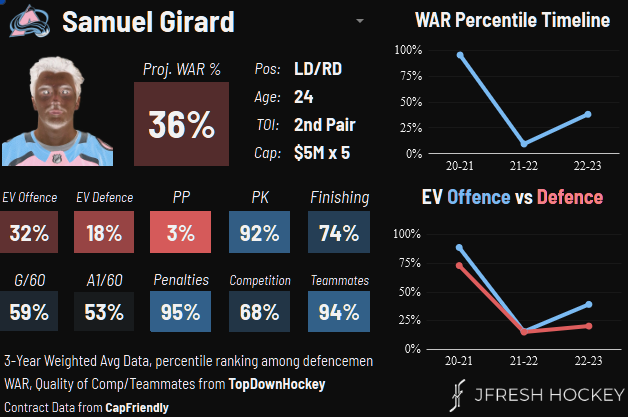
Keep in mind the numbers are weighted across three years, so Girard’s incredible season two years ago in the 56-game year play some role in the numbers, but so does last year’s bottoming out where it appeared there might be a problem brewing on Colorado’s hands.
I wish I had saved it at the time, but when I checked this player card back in January, it was significantly lower. I don’t remember all of the numbers, but it was not at 36% at the time.
So, you see some of the positives and negatives from Girard’s game here. He doesn’t take many penalties, he produces offense at even strength but not on the power play, he plays with great teammates and generally plays against good but not great competition. His play-driving is not very good and his defense leaves a whole lot to be desired.
Let’s look at some other data from this year.
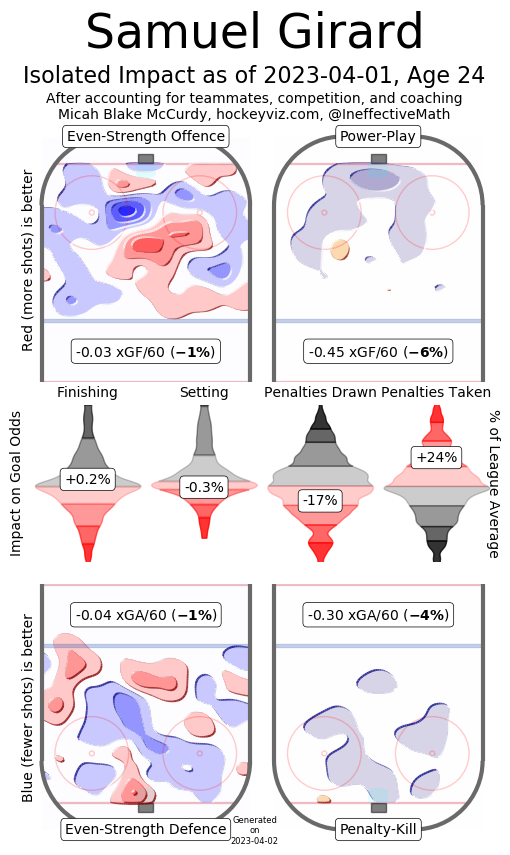
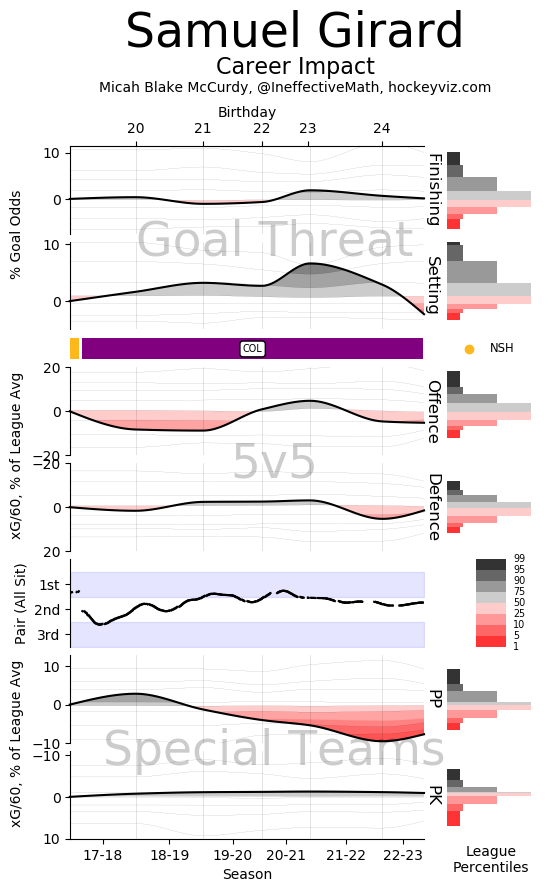
Here we see some things that surprised me a little bit. In contrast, the first graph above is strictly from this season, unlike the three-year player card at the top of this section. It has Girard as basically league average offensively and defensively, while being a poor distributor on the power play but surprisingly strong on the penalty kill.
The second graph, labeled “Career Impact” shows a snapshot of Girard’s entire career. We see similar themes here. His goal-scoring has never been a major threat but not non-existent, his playmaking has been much better in previous years, and more confirmation of what I mentioned above.
I wanted to compared that first graph to his career, so I pulled up his history.
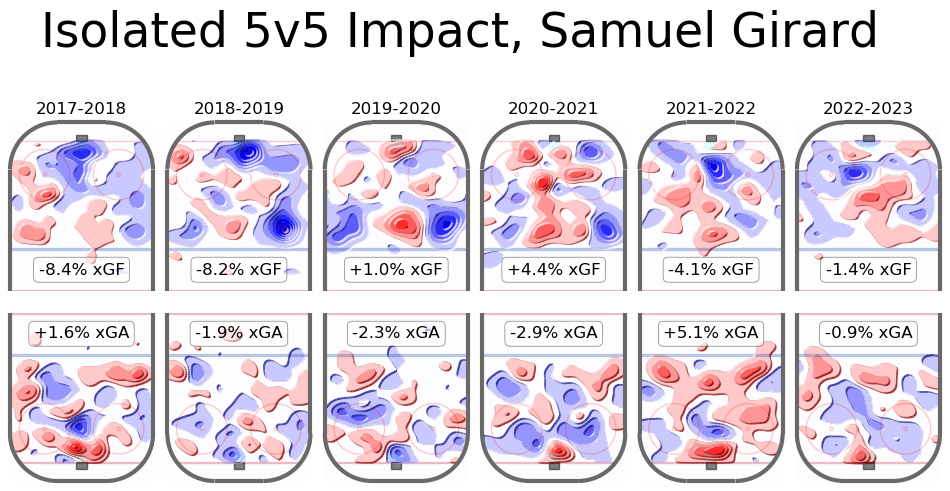
There are two major outliers here. Two seasons ago was the best combination of play-driving and defense and last year was the worst combination.
Outside of those two years, Girard has consistently been a league-average defender with not as much offense as you’d like, but it improved quite a bit from his first two years when the Avs were still transitioning from terrible to good.
It felt encouraging to see the defense, in particular, producing that kind of result this year.
This led me to Natural Stat Trick to check out where Girard ranked both on the Avs and among the NHL in some important categories, which was my second question.
Is Girard giving up more chances relative to teammates and the league?
Let’s start with the Avs and where he ranks among Colorado’s regulars (Makar, Toews, Erik Johnson, Byram, Girard) in the defensive metrics. I’m focusing on the defense because that’s where the crux of the argument surrounding his overall value lies. All numbers are at 5v5.
Corsi against per 60: 56.72 (4th)
Shots against per 60: 31.36 (4th)
Goals against per 60: 2.64 (5th)
Expected goals against per 60: 2.59 (3rd)
Scoring chances against per 60: 26.65 (3rd)
High danger chances against per 60: 12.44 (4th)
Let’s look at those same categories but against the league’s defenseman with a minimum of 600 minutes played at 5v5. 193 defenders qualify and this is where Girard ranks among those.
CA/60: 94th
SA/60: 131st
GA/60: 118th
xGA/60: 85th
SCA/60: 45th
HDCA/60: 117th
So nothing elite, nothing even really high-end. Girard does a pretty good job preventing scoring chances in general, but everything else is just okay. His actual shot prevention is his worst rate stat among that group.
What I did find interesting was some of the company he was keeping, especially regarding high-danger chances. Girard allows almost an identical number of high-danger chances per 60 minutes as Vladislav Gavrikov and Charlie McAvoy. Other guys in his range include Moritz Seider and Jake McCabe. That’s two of best young defenders in the NHL in McAvoy and Seider and two guys who were prized deadline acquisitions for Cup-contending teams in Gavrikov and McCabe. When you consider defending high-danger chances is specifically referring to guarding the front of one’s net, I found it interesting company for him to keep.
The conclusion here is that Girard is roughly Colorado’s third-best defenseman, sometimes fourth. I think if you surveyed most people and asked them to rank Colorado’s defenders, that’s a pretty fair ranking for him as he would certainly be behind Makar and Toews and I think there would be plenty of enthusiasm for slotting Byram ahead of Girard.
The answer to the original question of whether Girard was allowing more chances of all kinds relative to teammates and the rest of the league is, without question, no, certainly not to the degree that should be producing such an outlier at plus/minus.
Let’s head to our next question regarding everyone’s favorite topic, luck.
What role has luck played in Girard’s season?
Luck has always been extremely difficult to quantify, especially in a sport dominated by randomness such as hockey. Nobody who ever wins a lot wants to own that they got there in part because luck was on their side and everyone who loses a lot is dying to make luck part of the argument. It’s just how we are wired as humans.
What we do have in hockey to help us try to figure out if a player is getting really lucky or unlucky, is PDO, a fun stat that I don’t think actually stands for anything. It’s a simple math equation of adding a player’s on-ice shooting percentage with his on-ice save percentage. Anything over 1.000 is considered lucky, anything under is unlucky.
The idea is that over the course of a season, the vast majority of players will eventually see the numbers get close to 1.000.
Using that list of defensemen from earlier, right now Sam Girard’s PDO of 0.978 comes in at a cool 170 out of 193.
His on-ice save percentage is 91.58, good for right smack dab in the middle at 90. His on-ice shooting percentage, however, is 6.22, which ranks 190th. Only Jack Johnson, Patrik Nemeth, and Alex Goligoski have had worse finishing while on the ice.
The save percentage didn’t seem too out of line, so let’s take a look at that finishing instead.
Keep in mind, this is not individual finishing, where Girard is actually sitting on a career-high in goals for a season with six. This is about how the team around him scores while he’s out there.
At 5v5 this year with Girard on the ice, the Avs have been outscored 55-42. That’s pretty obviously a bad thing, but when you look just a little deeper, it gets more interesting than “Girard sux lol”.
He’s produced solid underlying percentages at 5v5.
Corsi: 51.76
Shots: 50.83
Expected goals: 49.96
Scoring chances: 52.56
High-danger chances: 47.57
The ones I want to focus on specifically here are expected goals and high-danger chances.
When it comes to expected goals against, Girard has been punished fairly with 55 goals against an expected goals number of 53.84. The 42 goals have been a far cry from the 53.77 expected goals he has produced at 5v5.
Looking at the high-danger numbers, his high-danger numbers are negative (see above) but the high-danger goals against number is at 42.86.
There’s a pretty clear pattern emerging here that Girard is getting punished for every mistake (again, pretty fairly when you look at the expected goals against), but the offense on the other end hasn’t ever come around to help make up for it.
In chart form, it looks something like this. Girard is the one with the blue square.
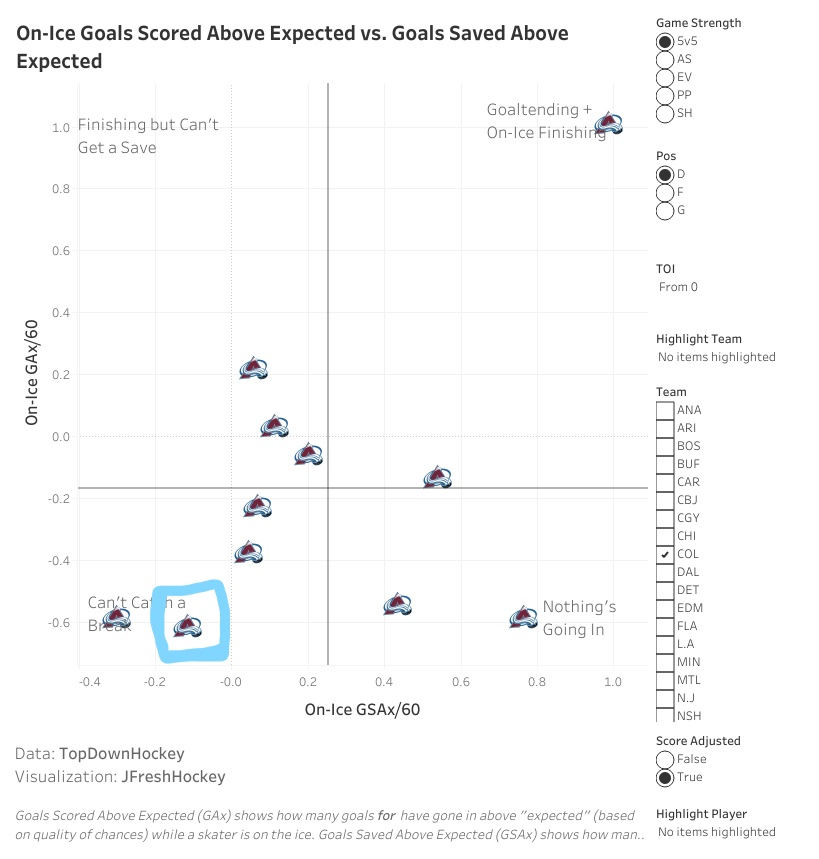
This leads to the last question posited at the start of the piece.
Has Girard gotten better or worse as the year has gone on?
It sure felt like there was a point in the year Girard started to turn things around and find his game. The reason I mentioned earlier in the piece going back and looking at Girard’s player card in January is that that’s when I thought he started to turn things around.
My eyes told me Girard seemed “back” and I wanted to see some numbers at the time. It was too early to really get into then, but now that the Avs are in the final two weeks of the season, we can take a look.
From the start of the season through December 31, Girard was a -12 in the first 29 games of the season and he registered only seven (!) points. That’s an 82-game pace of just 19 points, an unfathomably low number for a player of Girard’s talent.
In the 40 games since, he is still a -2 but has produced 26 points, an 82-game pace of 53 points, which is too high for a player who is probably fourth on Colorado’s defenseman depth chart when fully healthy.
If you want to get even more recent, Girard’s month of March had a little something for his supporters and haters alike as he finished with 10 points in 16 games but finished with a -8. Everyone eat up!
Jokes aside, the answer to this question is a very clear “yes”, even if you include that his March was maybe the ultimate example of why the conversation around Girard is as complicated as it is.
So, I’ve answered the questions I set out to at the start of the piece, but wanted to touch on a couple more things along the way so let’s find a few more questions to ask.
Is Girard overpaid given his role on the Avalanche?
Signed for four more seasons after this one at $5M, I think this is another area where both sides of the conversation have legs to stand on. Girard at $5M is probably overpaid a touch, maybe to the tune of $500K-$1M too much. Signed at the length he is, however, and with a salary cap that could be taking significant leaps in those four years, the value of the deal only goes up as long as Girard’s play normalizes more to the player he has been overall this year.
Here are Girard’s contract comps, per CapFriendly.
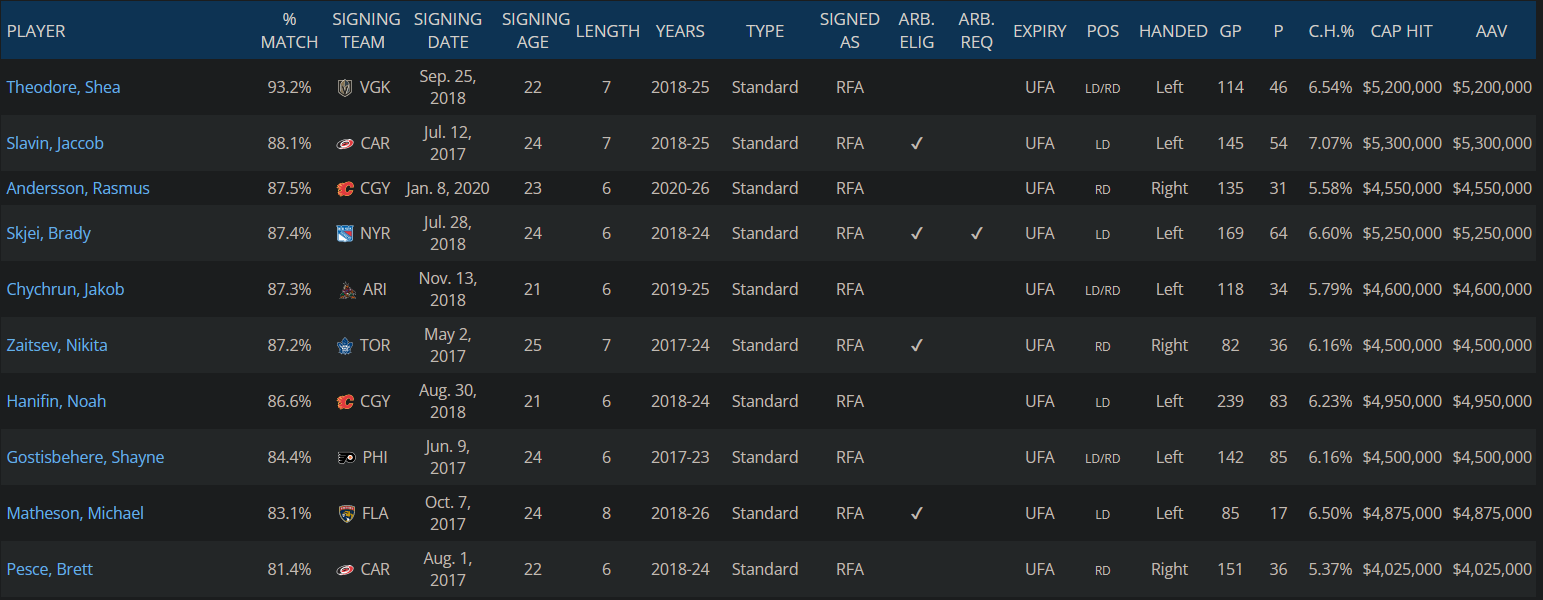 Of those ten players, the one I would definitively, no questions asked take over Girard are Theodore, Slavin, Pesce, and Hanifin.
Of those ten players, the one I would definitively, no questions asked take over Girard are Theodore, Slavin, Pesce, and Hanifin.
Chychrun is interesting because when he’s healthy and playing well, I think he’s better than Girard but Chychrun is plagued by both inconsistency and injuries, so I’m not sure I’d say yes there.
The rest of that list? Give me Girard.
One of the reasons I’d prefer Girard over Rasmus Andersson, in particular, is that Girard remains a wonderful stylistic fit in Colorado where transition play and exiting the zone with the puck are of paramount importance. This remains an area where Girard excels, as evidenced by his microstats.
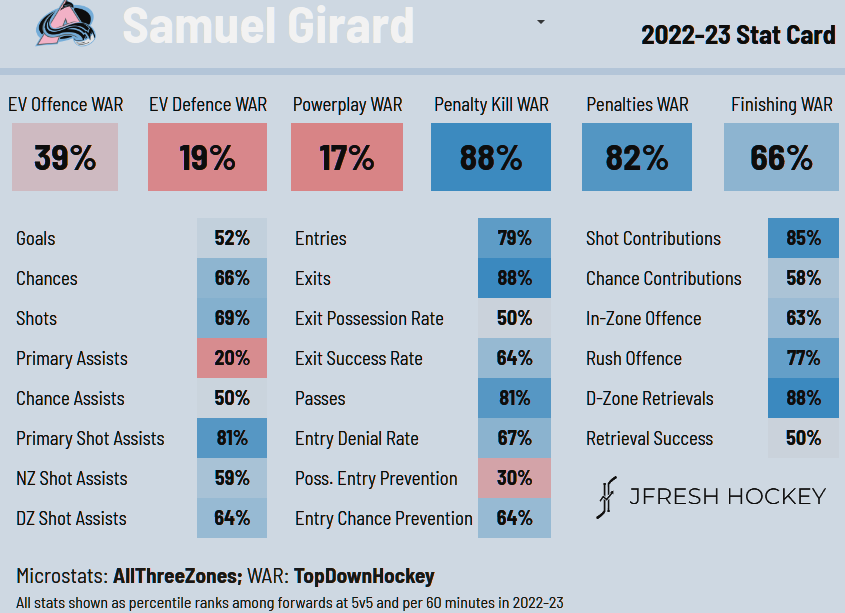
In a salary cap world where Byram and Toews have to get new contracts in the next two seasons, you can see the conversation swirling around Girard and the “need” to move him to free up the space required to keep those two.
All of that makes sense, but replacing Girard surely won’t come as cheaply or as easily as it gets assumed when those conversations do take place. Girard being cost-controlled for the next four years in an era where the cap is expected to take significant leaps is a very valuable thing for the Avalanche.
I’m not saying Girard is untouchable or anything of the sort, just that they need to be very careful how they proceed here. Making a big mistake is much easier than threading the needle, especially as a Cup contender who needs to pay guys.
Have you watched the games, nerd?
So there’s been a ton of information presented in various forms. A lot of this is the kind of data that old-school fans will push back on. There’s a decent chance one of you reading this right now is saying, “Okay, great, but why don’t you actually watch the games?”
So just for y’all, I went and clipped together this reel of nearly every even-strength goal Girard has been on the ice for this season (due to technical reasons, there are two missing but I think you’ll otherwise get the point).
I wanted to make sure I included this just so everyone can see, hopefully, what I saw when going through these. Girard absolutely makes some killer mistakes that are fairly punished and turned into goals. Girard is also a bystander to some killer mistakes from teammates. On one of these goals, he’s the guy jumping onto the ice for a bad change just as a breakaway is taking place (in Chicago, you might remember it).
If you got this far, I appreciate you giving it a read. I hope you approached it with an open mind. I know I did and I learned a lot along the way as I peeled back the layers of the Sam Girard onion.
The conversation around Girard isn’t nearly as black and white as the social media conversations would seem to make it and I enjoyed digging into some of the specifics of his season.
Comments
Share your thoughts
Join the conversation




